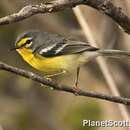 Multimedia w Wikimedia Commons
Multimedia w Wikimedia Commons Setophaga – rodzaj ptaka z rodziny lasówek (Parulidae).
Zasięg występowania
Rodzaj obejmuje gatunki występujące w Ameryce Północnej i Środkowej[7].
Morfologia
Długość ciała 11-15 cm; masa ciała 5–20,9 g[8].
Systematyka
Etymologia
-
Setophaga: gr. σης sēs, σητος sētos – ćma; -φαγος -phagos – -jedzący, od φαγειν phagein – jeść[9].
-
Parula: łac. parrula – mały ptak, wciąż niezidentyfikowany, ale wiązany z Parus lub Alauda przez kolejnych autorów (zdrobnienie parrus – ptak, różnie identyfikowany). W tym przypadku nazwa to została wykorzystyna przez Bonapartego jako zdrobnienie od rodzaju Parus Linnaeus, 1758, w którym to pierwotnie umieścił lasówkę obrożną[10]. Gatunek typowy: Sylvia americana Latham, 1787 = Parus americanus Linnaeus, 1758.
-
Wilsonia: Alexander Wilson (1766-1813) szkocko-amerykański pionier naturalizmu, ojciec amerykańskiej ornitologii[11]. Gatunek typowy: Motacilla mitrata J.F. Gmelin, 1789 = Muscicapa citrina Boddaert, 1783.
-
Dendroica: gr. δενδρον dendron – drzewo; gr. οικος oikos – mieszkaniec, od οικεω oikeō – mieszkać[12]. Gatunek typowy: Motacilla coronata Linnaeus, 1766.
-
Agreocantor: łac. ager, agri – pole, ziemia; cantor, cantoris – śpiewak, od cantare – śpiewać, od canere – śpiewać[13]. Gatunek typowy: Sylvicola kirtlandii S.F. Baird, 1852.
Podział systematyczny
Na podstawie analizy filogenetycznej do tego rodzaju (pierwotnie liczącego tylko jeden gatunek L. ruticilla) wyodrębniono gatunki z rodzajów Dendroica (S. plumbea, S. angelae, S. pharetra, S. kirtlandii, S. tigrina, S. cerulea, S. magnolia, S. castanea, S. fusca, S. petechia, S. pensylvanica, S. striata, S. caerulescens, S. palmarum, S. coronata, S. dominica, S. pityophila, S. pinus, S. vitellina, S. discolor, S. adelaidae, S. subita, S. delicata, S. graciae, S. nigrescens, S. townsendi, S. occidentalis, S. chrysoparia, S. virens)[14][15][16][17][18][19], Parula (S. americana, S. pitiayumi)[20][15][16][17][18][19], Wilsonia (S. citrina)[15][19]. Do rodzaju należą następujące gatunki[21]:
Przypisy
-
↑ Setophaga, w: Integrated Taxonomic Information System (ang.).
-
↑ W. Swainson. A Synopsis of the Birds discovered in Mexico by W. Bullock, F.L.S. and H.S., and Mr. William Bullock, jun. „The Philosophical Magazine”. New Series. 1, s. 368, 1827 (ang.).
-
↑ Bonaparte 1838 ↓, s. 20.
-
↑ Bonaparte 1838 ↓, s. 23.
-
↑ G.R. Gray: Appendix to a list the genera of birds. Wyd. 2nd ed., rev., augm., and accompanied with an index. London: Printed and sold by R. and J.E. Taylor, 1842, s. 8. (ang.)
-
↑ Ch.J. Maynard: Directory to the birds of eastern North America, illustrated with many wood cuts and twenty plates drawn and engraved by the author. West Newton: Mass., 1907, s. 243. (ang.)
-
↑ F. Gill & D. Donsker: New World warblers & oropendolas, Bananaquit (ang.). IOC World Bird List: Version 7.3. [dostęp 2017-09-19].
-
↑ J. Curson: Family Parulidae (New World Warblers). W: J. del Hoyo, A. Elliott & D.A. Christie: Handbook of the Birds of the World. Cz. 15: Weavers to New World Warblers. Barcelona: Lynx Edicions, 2010, s. 743-778. ISBN 978-84-96553-68-2. (ang.)
-
↑ Jobling 2017 ↓, s. Setophaga.
-
↑ Jobling 2017 ↓, s. Parula.
-
↑ Jobling 2017 ↓, s. Wilsonia.
-
↑ Jobling 2017 ↓, s. Dendroica.
-
↑ Jobling 2017 ↓, s. Agreocantor.
-
↑ I.J. Lovette & E. Bermingham. Explosive speciation in the New World Dendroica warblers. „Proceedings of the Royal Society B”. 266, s. 1629-1636, 1999 (ang.).
-
↑ a b c I.J. Lovette & E. Bermingham. What is a Wood-Warbler? Molecular characterization of a monophyletic Parulidae. „The Auk”. 119 (3), s. 695-714, 2002 (ang.).
-
↑ a b N.K. Klein, K.J. Burns, S.J. Hackett & C.S. Griffiths. Molecular phylogenetic relationships among the wood warblers (Parulidae) and historical biogeography in the Caribbean basin. „The Journal of Caribbean Ornithology”. Special Issue. 17, s. 3-17, 2004 (ang.).
-
↑ a b D.L. Rabosky & I.J. Lovette. Density-dependent diversification in North American wood warblers. „Proceedings of the Royal Society B”. 275 (1649), s. 2363-2371, 2008. DOI: 10.1098/rspb.2008.0630 (ang.).
-
↑ a b J.T. Weir, E. Bermingham & D. Schluter. The Great American Biotic Interchange in birds. „Proceedings of the National Academy Sciences”. 106 (51), s. 21737–21742, 2009. DOI: 10.1073/pnas.0903811106 (ang.).
-
↑ a b c I.J. Lovette, J.L. Pérez-Emán, J.P. Sullivan, R.C. Banks, I. Fiorentino, S. Córdoba-Córdoba, M. Echeverry-Galvis, F.K. Barker, K.J. Burns, J. Klicka, S.M. Lanyon & E. Bermingham. A comprehensive multilocus phylogeny for the wood-warblers and a revised classification of the Parulidae (Aves). „Molecular Phylogenetics and Evolution”. 57 (2), s. 753-770, 2010. DOI: 10.1016/j.ympev.2010.07.018 (ang.).
-
↑ I.J. Lovette & E. Bermingham. Mitochondrial perspective on the phylogenetic relationships of the Parula wood-warblers. „The Auk”. 118 (1), s. 211-215, 2001 (ang.).
-
↑ Systematyka i nazwy polskie za: P. Mielczarek M. Kuziemko: Rodzina: Parulidae Wetmore, Friedmann, Lincoln, Miller,AH, Peters,JL, van Rossem, Van Tyne & Zimmer,JT, 1947 - lasówki - New World wood warblers (wersja: 2017-07-09). W: Kompletna lista ptaków świata [on-line]. Instytut Nauk o Środowisku Uniwersytetu Jagiellońskiego. [dostęp 2017-09-19].
-
↑ B.D. McKay, M. Bryant, J. Reynolds, W.K. Hayes & D.S. Lee. Evidence for the Species Status of the Bahama Yellow-Throated Warbler (Dendroica “Dominica” Flavescens). „The Auk”. 127 (4), s. 932-939, 2010. DOI: 10.1525/auk.2010.09093 (ang.).
Bibliografia
- C.L. Bonaparte: A geographical and comparative list of the birds of Europe and North America. London: J. Van Voorst, 1838, s. 2-67. (ang.)

